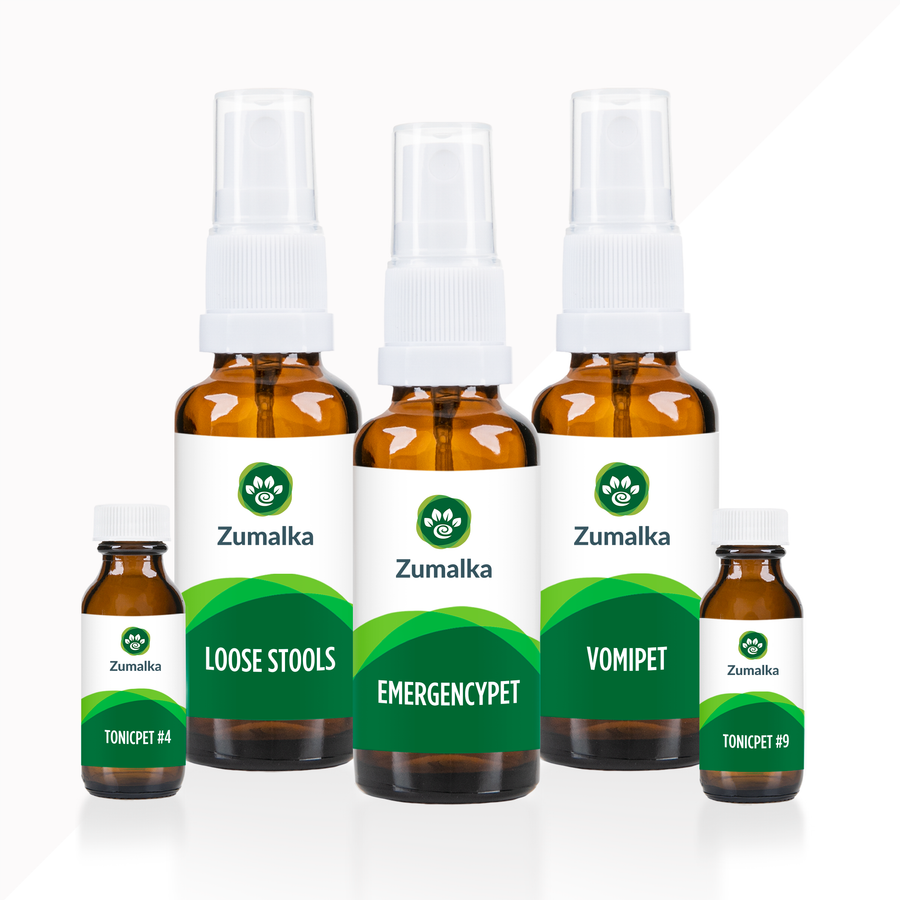Expert Insights: 12 Cat Emergencies You Should Never Ignore
Cats are skilled at concealing illness or pain, often making emergencies hard to detect. Recognizing the warning signs early can be vital to your cat’s health and survival.
Cat emergencies can happen without warning and often demand swift veterinary and pet homeopathy care. Quick action can mean the difference between a full recovery and a life-threatening situation.
If you're ever unsure, contact your veterinarian, homeopathic pet expert, or the nearest animal hospital immediately. This guide covers common cat emergencies, key warning signs, and the urgent steps every cat owner should take.
Recognizing When Your Cat Is in Distress
Compared to dogs, cats often hide discomfort even more, making it harder to spot health issues early. By learning to recognize subtle signs of distress, you can intervene before problems become serious.
Subtle changes in your cat’s behavior, like hiding, reduced activity, sleeping for too long, or altered appetite, can signal serious distress. Watch for unusual breathing, vocalizations, bathroom habits, or signs like staggering and collapse to catch emergencies early.
12 Cat Emergencies That Can Strike at Any Time

Emergencies in cats are more common than many owners realize, and they can happen without warning. This section covers the most frequent cat emergencies and how recognizing them early can help you take quick, potentially life-saving action.
#1. Difficulty breathing, coughing, or choking
Breathing difficulties, coughing, or choking in cats are urgent warning signs that demand immediate veterinary care. Symptoms like open-mouth breathing, wheezing, or labored breathing can signal a potentially life-threatening emergency.
Signs of choking in cats may include coughing, drooling, gagging, pawing at the mouth, and sudden agitation. If you suspect choking, avoid putting your fingers in the cat’s mouth and seek immediate veterinary help.
#2. Bleeding
Bleeding in cats, especially if it doesn’t begin to slow in 1 maximum 2 minutes, requires immediate veterinary attention. It may be caused by deep wounds or internal injuries and can quickly become life-threatening.
To control minor or moderate bleeding, applying pressure may be sufficient. Here’s why: in cases of severe bleeding, no one should wait—not even for a minute, in my opinion. Pets should be rushed to a veterinarian immediately. Severe bleeding typically cannot be controlled with pressure alone; in most cases, surgical intervention is required.
Severe bleeding can be a life-threatening situation, and you must seek veterinary care as soon as possible. Apply pressure and take your cat to the nearest vet clinic.
#3. Suspected poisoning
Suspected poisoning in cats is a medical emergency that can result from ingesting toxins like antifreeze, rodenticides, lilies, human medications, or household cleaners. Even small amounts can be deadly, so immediate veterinary care is essential.
Poisoning symptoms in cats can include vomiting, diarrhea, excessive drooling, skin irritation, seizures, or sudden collapse. Never administer human medication unless specifically directed by a veterinarian, as it can be highly toxic to cats.
If you suspect poisoning, bring a sample and the original container to the veterinarian for proper identification. Never induce vomiting if your cat has ingested corrosive substances or foreign objects, as this can cause further harm.
#4. Seizures, collapse, or unconsciousness
Seizures in cats involve sudden, uncontrolled spasms and typically last under two minutes. If a seizure lasts one or two minutes and occurs repeatedly, seek immediate veterinary care, as it may signal a serious underlying condition.
During a seizure, protect your cat from injury by clearing the area and never placing your hands near its mouth. Collapse or unconsciousness requires immediate emergency care and may result from serious issues like heart failure or head trauma.
#5. Urinary tract blockage (particularly in male cats)
Urinary tract blockages are especially dangerous in male cats due to their narrower urinary passages. Left untreated, this condition can rapidly become life-threatening, leading to kidney damage or fatal complications.
A “blocked cat” may show signs such as frequent litter box visits, straining without urination, vocalizing in pain, or urinating outside the box. As the blockage worsens, symptoms like vomiting and lethargy can appear. Immediate veterinary attention is critical.
#6. Severe or persistent vomiting and diarrhea
Persistent vomiting or diarrhea in cats can cause rapid dehydration and signal a serious underlying issue. Possible causes include poisoning, gastrointestinal obstruction, or infection. Immediate veterinary care is essential to prevent complications.
Seek veterinary care if vomiting or diarrhea lasts more than 6–12 hours, contains blood, or if your cat becomes weak or unresponsive. Never force food or water, as this can worsen the condition. However, you can offer small amounts of water to avoid dehydration if your cat is alert and responsive.
#7. Eye injuries
Eye injuries in cats can lead to pain, vision loss, or even permanent damage if left untreated. Watch for signs like swelling, discharge, excessive tearing, squinting, sudden pupil changes, or signs of blindness, and seek prompt veterinary care.
Sudden blindness in cats can be a sign of glaucoma, a serious condition that can progress rapidly. Immediate veterinary treatment is essential to prevent permanent vision loss.
#8. Trauma
Trauma from accidents, falls, or fights can cause serious injuries such as broken bones, internal bleeding, or head trauma in cats. Even if your cat appears fine, internal injuries may not be immediately visible and require prompt veterinary evaluation.
If your cat has experienced trauma, handle them gently by supporting their body to prevent further injury. Use a secure carrier or box to transport them safely, keeping injured areas as stable as possible.
Penetrating wounds to the chest or abdomen, head injuries, or breathing difficulties after trauma are critical emergencies. Any trauma, no matter how minor it seems, warrants a prompt veterinary exam to rule out internal damage.
#9. Heatstroke
Heatstroke in cats is a life-threatening emergency that can cause excessive panting, drooling, lethargy, bright red gums, and even unconsciousness. It often occurs when a cat is trapped in a hot, poorly ventilated space, like a car, and requires immediate veterinary care.
If you suspect heatstroke, begin cooling your cat immediately using cool (not ice-cold) water and seek emergency veterinary care. Heatstroke is always a critical medical emergency and can be fatal without prompt treatment.
#10. Severe allergic reactions
Severe allergic reactions in cats, such as anaphylaxis, can cause rapid-onset symptoms including facial swelling, hives, vomiting, and diarrhea. These can quickly escalate to breathing difficulties and collapse. Prompt emergency veterinary care is critical.
Severe allergic reactions in cats can be triggered by insect stings, vaccines in rare cases, or contact with environmental allergens. Immediate veterinary attention is essential to prevent rapid progression to a life-threatening emergency.
#11. Sudden inability to use hind legs
Sudden paralysis of the hind legs in cats may indicate a saddle thrombus, a serious blood clot often associated with heart disease. This painful and life-threatening condition demands immediate veterinary care.
Symptoms of a saddle thrombus include sudden hind leg paralysis, severe pain, and changes in breathing. Immediate veterinary care is essential for pain relief and to assess the underlying cause.
#12. Foreign object ingestion
Cats may ingest foreign objects like string, yarn, or ribbon, items especially dangerous due to the risk of intestinal damage. Linear foreign bodies can cause life-threatening injuries and require immediate veterinary intervention.
Signs of foreign object ingestion in cats include vomiting, loss of appetite, diarrhea, and weakness. If a string or object is visible, never pull on it. Immediate veterinary care is needed, and surgery may be required.
Cat Emergency? Here’s What to Do Immediately

If your cat is facing a medical emergency, staying calm and acting quickly is crucial. Keep these essential steps in mind to ensure your cat gets the care they need as fast as possible:
- Staying calm during a cat emergency helps you think clearly and prevents further stress for your pet. Your composure can make a critical difference in how quickly and effectively you respond.
- Before helping your cat, assess the scene for any immediate dangers to you or your pet. Ensuring a safe environment prevents further injury and allows you to respond more effectively.
- If trauma, broken bones, or neurological symptoms are suspected, minimize your cat’s movement to prevent further injury. Keep them warm, quiet, and as calm as possible until you reach veterinary care.
- Contact your veterinarian immediately and clearly describe the situation, they can offer first aid guidance and get ready for your arrival. Consulting a pet homeopathy expert may also provide supportive care alongside emergency treatment.
- For safe transport, use a secure carrier or sturdy box to avoid further injury. If your cat is hurt, gently lift them using a towel or blanket, and be cautious. Frightened or injured cats may bite or scratch.
- In an emergency, it’s important to reach the vet quickly, but always drive carefully to keep you and your cat safe. Staying calm and focused behind the wheel ensures the best chance for timely, effective care.
- When you arrive at the vet, be ready to share your cat’s medical history, current medications, and details of the emergency. This information helps the veterinary team make faster, more accurate treatment decisions.
Are There Natural Remedies That Support Cats During Emergencies?
Zumalka’s EMERGENCYPET KIT is your go-to solution for urgent pet care, designed to keep you prepared for unexpected situations. Suitable for all animals, including cats, dogs, rabbits, and horses, it supports intestinal balance and overall well-being. Keep it on hand to help promote comfort and recovery when accidents or emergencies strike.
The EMERGENCYPET kit includes LOOSE STOOLS, VOMIPET, EMERGENCYPET, TONICPET #4, and TONICPET #9. This kit is thoughtfully designed to help you stay proactive in urgent situations. Keeping it on hand ensures you're ready to respond quickly when your pet isn’t feeling well.
Post-Emergency Care: Helping Your Cat Recover

After an emergency visit, carefully review and follow all discharge instructions provided by your veterinarian or pet homeopathy expert. Administer any prescribed medications exactly as directed to support your cat’s recovery and prevent complications.
Limit your cat’s activity as recommended, especially after surgery or injury, to promote proper healing. Use a quiet room or secure carrier to help keep them calm and prevent further strain or damage.
Monitor your cat closely for any changes in behavior, appetite, or mobility during the recovery period. Follow-up veterinary visits and pet homeopathy specialist consultations are essential to track healing progress and catch potential complications early.
Even if your cat seems fully recovered after an emergency, a veterinary check-up or pet homeopathy consultation is still essential. Some injuries or complications may not be immediately visible and can worsen without proper evaluation.
Key Takeaways
Recognizing the signs of common cat emergencies is a key part of being a responsible pet owner. Preparation allows you to act quickly and confidently, making all the difference in protecting your cat’s health and safety.
Taking prompt action and seeking expert veterinary care or trusted pet homeopathy support can greatly improve your cat’s chances of recovery. Acting quickly ensures the best possible outcome in any emergency.
Trust your instincts. If something seems off with your cat, don’t hesitate to contact your veterinarian. Seeking additional guidance from a qualified pet homeopathy expert can also provide valuable support. Early action is key to identifying and treating serious health issues before they worsen.
FAQs
What is considered an emergency for a cat?
Cat emergencies include difficulty breathing, collapse, seizures, poisoning, moderate to severe bleeding, trauma, or sudden inability to urinate. Prompt veterinary care is essential to protect your cat’s health and prevent serious complications.
What is the most common fatal disease in cats?
Feline infectious peritonitis (FIP) is a leading fatal disease in cats. Triggered by a mutated feline coronavirus, it causes severe inflammation, organ failure, and is often deadly without early diagnosis and treatment.
How to tell if a cat is suffering?
A suffering cat may hide, vocalize unusually, lose appetite, show lethargy, or display behavior changes. Watch for signs like rapid breathing, limping, or aggression, and consult your veterinarian promptly. Getting in touch with a pet homeopathy specialist can also provide added support.
What is life-threatening to cats?
Life-threatening conditions in cats include urinary blockages, respiratory distress, poisoning, trauma, seizures, and heart disease. These emergencies require immediate veterinary care to prevent serious complications, organ failure, or death. Quick action can save your cat’s life.
What is the deadliest poison for cats?
The deadliest poison for cats is antifreeze (ethylene glycol), which is highly toxic even in small amounts. It causes rapid kidney failure and death without immediate veterinary treatment. Keep all toxins securely stored.
What is sudden death in cats?
Sudden death in cats is often caused by hidden conditions like heart disease, blood clots, or internal bleeding. These events occur without warning, making regular checkups and early detection vital for preventing unexpected loss.
What is the silent killer of cats?
Heart disease, particularly hypertrophic cardiomyopathy, is often called the silent killer of cats. It progresses with few or no symptoms until a sudden collapse or death, making early detection through regular vet checkups essential.
What disease kills cats quickly?
Feline infectious peritonitis (FIP) is a fast-acting, often fatal disease in cats. Caused by a mutated virus, it can progress rapidly, leading to severe symptoms and death without prompt diagnosis and care.
Can cats have heart attacks?
While rare, cats can experience heart attacks, usually linked to underlying heart disease like hypertrophic cardiomyopathy. Symptoms may include collapse, labored breathing, or sudden death. Prompt veterinary care or pet homeopathy guidance is crucial for diagnosis and treatment.
How do I know if my cat's heart is failing?
Signs of heart failure in cats may include labored breathing, lethargy, coughing, reduced appetite, and sudden hind leg weakness. Prompt veterinary evaluation is essential, and consulting a qualified pet homeopath may provide additional supportive care.
Can cats have panic attacks?
Cats can experience panic-like episodes triggered by fear, loud noises, or stressful environments. Signs include hiding, trembling, vocalizing, or aggression. Understanding your cat’s triggers and providing a calm space can help reduce anxiety.
How to tell if your cat is having a stroke?
Stroke symptoms in cats include sudden loss of balance, head tilt, disorientation, circling, or unusual eye movements. Prompt veterinary care is essential to confirm the diagnosis and begin treatment.
What does renal failure look like in cats?
Renal failure in cats may present as increased thirst and urination, weight loss, vomiting, bad breath, lethargy, and poor appetite. These symptoms often progress gradually. Early diagnosis and veterinary care are crucial for managing the condition.
How to know if a cat is having a seizure?
A cat having a seizure may show signs like sudden collapse, muscle twitching, drooling, loss of consciousness, or uncontrolled movements. Seizures typically last under two minutes. Seek immediate veterinary evaluation for proper diagnosis.
How long can a cat survive after a stroke?
A cat’s survival after a stroke depends on the cause, severity, and how quickly treatment begins. Some cats recover within days to weeks with proper care, while others may experience lasting effects or require long-term management.








Hi Lynne, We reached out to you via your email with some personalized recommendations for Abbee, please let us know how it goes!
Our 11 year old Maine Coon tabby female Abbee had dental cleaning last fall and was dx with possible Stomaitis. They suggested pulling all her teeth and that is not an option after research. She eats but only soft food now. While she was over weight she is at 10.4 lbs now. I am seeking more understanding what causes this dx. We are giving her holistic drops, olive leaf spray and another drop from bee pollen to coat her gums in the morning.
Hi Mary, Thank you for that useful information! There certainly are many emergency situations that we need to be aware of to protect our pets.
I noticed in your article that you didn’t mention cats getting blocked in the urinary tract. Many people still don’t know about this and if their cat got blocked they wouldn’t have a clue except maybe it’s using the box more than usual. The cat can die within 48 hours so I think that’s an emergency too. I have known cat owners in the past who asked ME what was wrong with them. I had to tell them that it was an emergency. One guy lost his favorite cat because he didn’t know.
Leave a comment